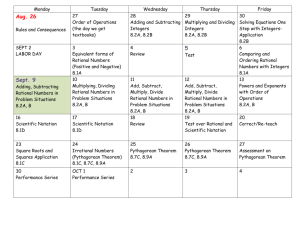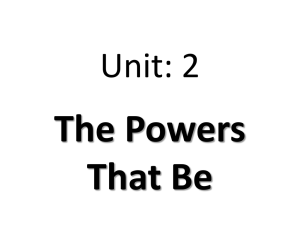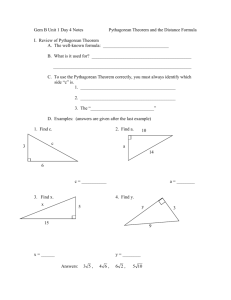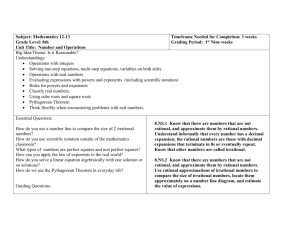Subject:
advertisement
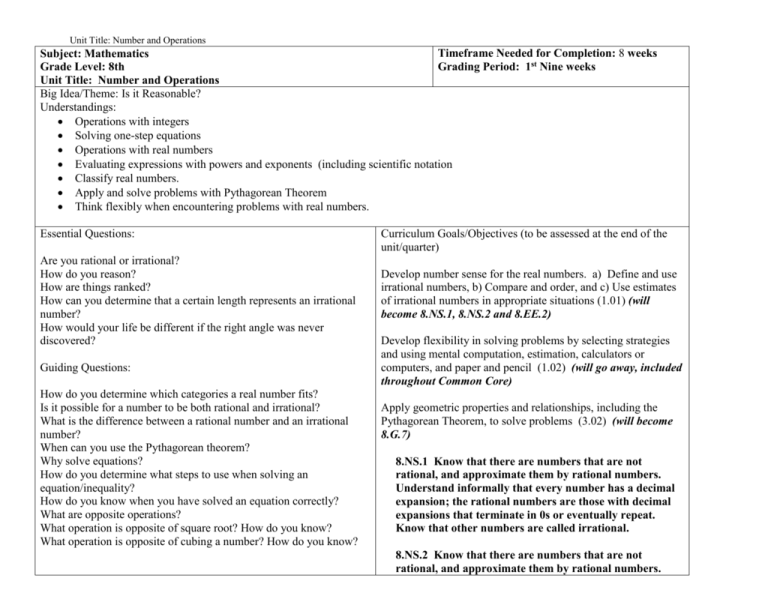
Unit Title: Number and Operations Timeframe Needed for Completion: 8 weeks Subject: Mathematics Grade Level: 8th Grading Period: 1st Nine weeks Unit Title: Number and Operations Big Idea/Theme: Is it Reasonable? Understandings: Operations with integers Solving one-step equations Operations with real numbers Evaluating expressions with powers and exponents (including scientific notation Classify real numbers. Apply and solve problems with Pythagorean Theorem Think flexibly when encountering problems with real numbers. Essential Questions: Are you rational or irrational? How do you reason? How are things ranked? How can you determine that a certain length represents an irrational number? How would your life be different if the right angle was never discovered? Guiding Questions: How do you determine which categories a real number fits? Is it possible for a number to be both rational and irrational? What is the difference between a rational number and an irrational number? When can you use the Pythagorean theorem? Why solve equations? How do you determine what steps to use when solving an equation/inequality? How do you know when you have solved an equation correctly? What are opposite operations? What operation is opposite of square root? How do you know? What operation is opposite of cubing a number? How do you know? Curriculum Goals/Objectives (to be assessed at the end of the unit/quarter) Develop number sense for the real numbers. a) Define and use irrational numbers, b) Compare and order, and c) Use estimates of irrational numbers in appropriate situations (1.01) (will become 8.NS.1, 8.NS.2 and 8.EE.2) Develop flexibility in solving problems by selecting strategies and using mental computation, estimation, calculators or computers, and paper and pencil (1.02) (will go away, included throughout Common Core) Apply geometric properties and relationships, including the Pythagorean Theorem, to solve problems (3.02) (will become 8.G.7) 8.NS.1 Know that there are numbers that are not rational, and approximate them by rational numbers. Understand informally that every number has a decimal expansion; the rational numbers are those with decimal expansions that terminate in 0s or eventually repeat. Know that other numbers are called irrational. 8.NS.2 Know that there are numbers that are not rational, and approximate them by rational numbers. Unit Title: Number and Operations Use rational approximations of irrational numbers to compare the size of irrational numbers, locate them approximately on a number line diagram, and estimate the value of expressions. 8.EE.1 Work with radicals and integer exponents. Know and apply the properties of integer exponents to generate equivalent numerical expressions. (from Algebra 1) 8.EE.2 Work with radicals and integer exponents. Use square root and cube root symbols to represent solutions to the equations of the form x2 = p and x3 = p, where p is a positive rational number. Evaluate square roots of small perfect squares and cube roots of small perfect cubes. Know that √2 is irrational. 8.EE.3 Work with radicals and integer exponents. Use numbers expressed in the form of a single digit times an integer power of 10 to estimate very large or very small quantities, and to express how many times as much one is than the other. (moved from 6th grade) 8.EE.4 Work with radicals and integer exponents. Perform operations with numbers expressed in scientific notation, including problems where both decimal and scientific notation are used. Use scientific notation and choose units of appropriate size for measurements of very large or very small quantities. Interpret scientific notation that has been generated by technology. (from Algebra 1) 8.G.7 Understand and apply the Pythagorean Theorem. Apply the Pythagorean Theorem to determine unknown side lengths in right triangles in real-world and mathematical problems in two and three dimensions. 8.G.6 Understand and apply the Pythagorean Theorem. Explain a proof of the Pythagorean Theorem and its converse. (NEW) Unit Title: Number and Operations 8.G.8 Understand and apply the Pythagorean Theorem. Apply the Pythagorean Theorem to find the distance between two points in a coordinate system. (from Algebra 1) Assessment Tasks: Essential Skills/Vocabulary: Vocabulary radical terminating decimal repeating decimal non-terminating non-repeating pi, π square root radicand perfect square legs hypotenuse right triangle Pythagorean triple Essential Skills Estimate radical numbers to the nearest integer and between two integers. Order real numbers. Classify real numbers into rational and irrational. Determine factors and multiples of sets of numbers Solve real-world word problems involving rational numbers Draw right triangles, squares or rectangles from real-world word problems and know when to use Pythagorean theorem (diagonals) Evaluate the Pythagorean theorem equation given one or two sides: a leg and hypotenuse, 2 legs or one leg(square or isosceles right triangle) Simplify radical expressions Determine when two radical expressions are equivalent Problem Solving Skills guess and test make a table/chart/ make a diagram/picture make an organized list work backwards work a simpler problem extraneous information Class Discussions Learning Logs Cornell Notes Think-Pair-Share Assessment Tasks con’t: Concept Maps Graphic Organizers/Venn Diagrams Graphic Organizers/Venn Diagrams Interactive Notebook Groupwork Projects Quickwrites Foldables RAFTS Unit Title: Number and Operations Materials Suggestions: NCDPI Resources: http://www.ncpublicschools.org/curriculum/mathematics/middlegrades/grade08/ http://mathlearnnc.sharpschool.com/cms/One.aspx?portalId=4507283&pageId=5149151 National Library of Manipulatives http://nlvm.usu.edu/en/nav/vlibrary.html NCTM Illuminations http://illuminations.nctm.org/ Lesson Plan sites and Activities: http://www.lessonplanspage.com/Math.htm http://www.ilovemath.org Math Graphic Organizers http://www.enchantedlearning.com/graphicorganizers/math/ Wheel of Theodoras Project- Using Pythagorean theorem to form spiraling right triangles to create a picture: http://www.ldlewis.com/Teaching-Mathematics-with-Art/Wheels.html Problem Solving/Problem Websites http://library.thinkquest.org/25459/learning/problem/ http://www.geom.uiuc.edu/~lori/mathed/problems/problist.html http://www.rhlschool.com/math.htm http://nces.ed.gov/nationsreportcard/itmrlsx/search.aspx AVID Library/Mathematics Write Path Books I and II

